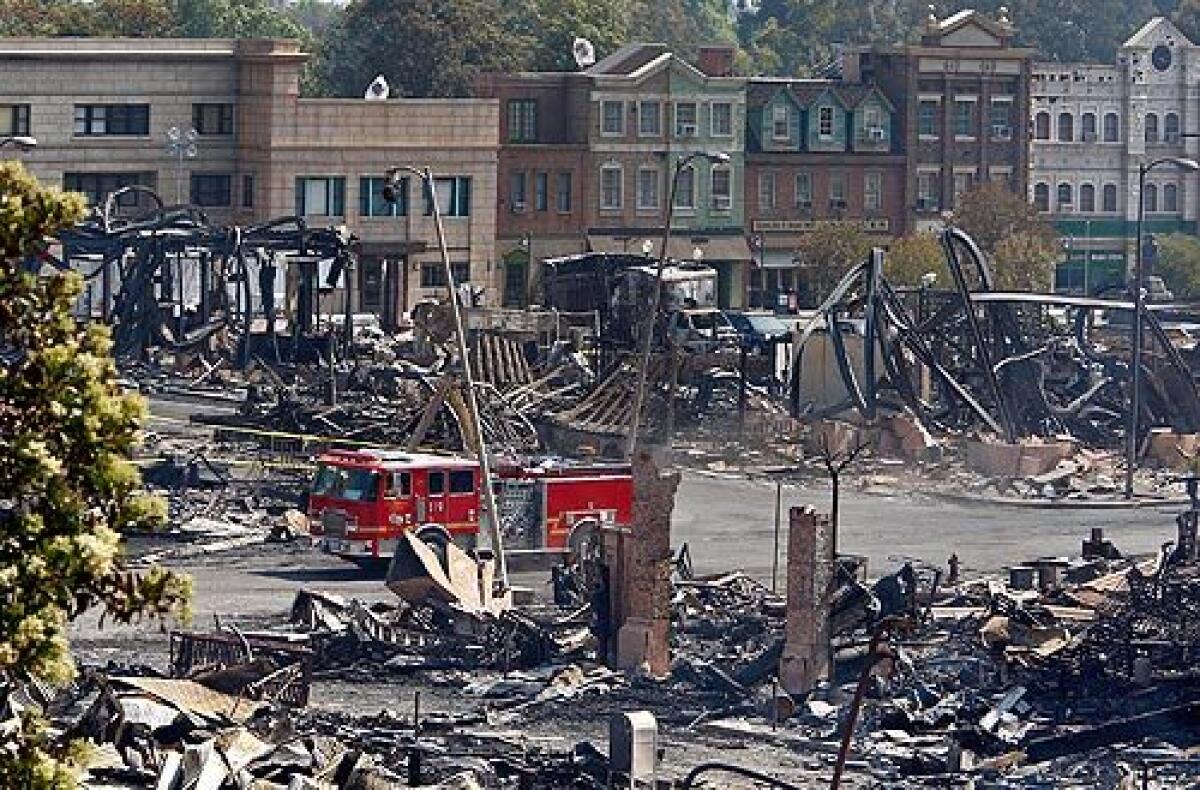Universal Music Group, in initial count, cites only 22 masters lost in fire

- Share via
Universal Music Group officials have initially identified only 22 original master recordings made by five artists that may have been destroyed in the 2008 vault fire, according to an internal memo issued Wednesday, a copy of which was obtained by The Times.
Those were identified through UMG’s efforts in recent weeks to inform musicians, their managers and lawyers precisely what was destroyed more than a decade ago in a disaster brought to light in June in a New York Times Magazine exposé.
Wednesday’s memo was written by Pat Kraus, UMG‘s senior vice president of recording studios and archive management, at the behest of Chairman and Chief Executive Lucian Grainge.
“Over the past several weeks,” the memo states, “our team has been working around the clock, fielding requests from approximately 275 artists and representatives. To date we’ve reviewed 26,663 individual assets covering 30 artists. Of those assets, we believe we’ve identified 424 that could be missing or lost due to the fire, with audio assets accounting for 349 of them.
“Our data suggests that 22 of those could be ‘original masters’ which are associated with five artists,” it continued. “For each of those lost masters, we have located high-quality alternate sources in the form of safety copies or duplicate masters. As we complete new work and we fill in gaps of work we’ve already done, these tallies will continue to evolve by the hour.”
One of the lawyers representing musicians in a class-action lawsuit, filed last month on behalf of musicians whose recordings may have been lost, told The Times Wednesday, “I don’t really know what that even means. Significantly, they have not been able to give us status on any of the dozens of artists that have asked us to inquire — except one, for which the information has not been verified,” said Edwin F. McPherson, principal at McPherson LLP. “I don’t know what this apparently random sampling of 30 artists is, but it does not appear to be any of our artists, and I am very curious as to their methodology — and why they didn’t do this 11 years ago.”
Howard King, another of the lawyers who filed the class-action suit, asked, “Why not show us the sworn declarations of losses they filed in their lawsuits against NBCUniversal and their insurance company? I wonder if those are consistent with what they are now claiming?”
The class-action suit was filed on behalf of Soundgarden, Hole, Steve Earle, Tom Petty’s ex-wife Jane Petty, Afeni Shakur Trust representative Tom Whalley “and on behalf of all others similarly situated.”
The UMG statement added, “Of course, our work is just beginning. In the coming weeks and months we will continue to update our artists and internal teams with our progress.”
The memo was distributed just a few hours before UMG filed a motion in U.S. Central District Court to dismiss the class-action suit that seeks at least $100 million in damages, including a portion of a multimillion dollar settlement UMG reached in 2012 with NBCUniversal and its insurers over the lost recordings.
UMG lawyers argued that the master recordings at hand belonged to UMG, not the musicians or their representatives, so any losses suffered were the company’s. Further, musicians could not claim they were entitled to half the proceeds from the UMG-NBCUniversal settlement because such money falls outside UMG’s obligation to share proceeds with artists for “furnishing, licensing or authorizing the use by others of master recordings embodying their musical works.” UMG’s motion also argued that the statute of limitations to seek legal relief has expired.
UMG’s internal memo also included a question-and-answer session that Kraus said summarized some of the questions most commonly asked by musicians and their representatives since the June 11 publication of the New York Times Magazine investigation, the accuracy of which is disputed in the memo.
“This is not to say there weren’t losses in the fire,” Kraus wrote, “it’s simply to say that the Times report is not a reliable source for what was lost and as a result it has created significant confusion.”
The first question in the memo addressed why UMG has not published a list of everything that was lost when fire ravaged a storage facility in which UMG was renting space from NBCUniversal Studios on the lot of the latter’s Universal Studios.
“While it would be ideal if we could publish such a list, unfortunately, it’s not that simple,” Kraus wrote. “[T]here is no definitive list of what was destroyed in the fire because it affected both inventoried assets and those that were not inventoried.”
That corresponds to statements that audio engineers and archivists with knowledge of the storage facility have made to the Los Angeles Times and other media outlets since the New York Times report was published.
Several sources have confirmed that the vault did indeed house a vast repository of original master recordings by innumerable artists. Speaking on the condition of anonymity, they have told The Times that it may indeed be impossible to know exactly how many and which recordings were destroyed because a comprehensive inventory of what was in the vault does not exist.
An entire wall was filled with tape boxes identified only by numbers, one source told The Times, but there was no catalog of what those numbers corresponded to, and no other labeling information on the boxes.
The New York Times Magazine story said perhaps as many as 500,000 master recordings dating back decades were destroyed, including many by Louis Armstrong, Bing Crosby, Billie Holiday, Judy Garland, Chuck Berry, Buddy Holly, Elton John, Tom Petty & the Heartbreakers, Nirvana, Soundgarden and multiple other artists.
In the immediate aftermath of the fire more than a decade ago, Universal representatives assured the Los Angeles Times and other media outlets that the facility housed only copies of recordings, and stated on the record, “In essence, nothing was lost.” Spokespeople also emphasized that digital copies exist for the original analog tapes in the vault, but subsequently that assertion has been subject to intense debate.
“Immediately after the fire,” according to the class-action suit, “UMG embarked on a systematic and fraudulent scheme of misrepresentation and misdirection designed to conceal the loss of the master recordings destroyed in the fire.”
Even though record companies such as UMG typically retain ownership of such master recordings, from which commercial singles, albums, reissues and other iterations of the music are usually drawn, any loss of such recordings can affect artists because they can regain ownership through copyright reversion or other contractual means.
More to Read
Updates
7:17 p.m. July 17, 2019: This article has been updated with details on Universal Music Group’s motion to dismiss the class-action lawsuit filed on behalf of musicians whose recordings may have been destroyed.
The biggest entertainment stories
Get our big stories about Hollywood, film, television, music, arts, culture and more right in your inbox as soon as they publish.
You may occasionally receive promotional content from the Los Angeles Times.










